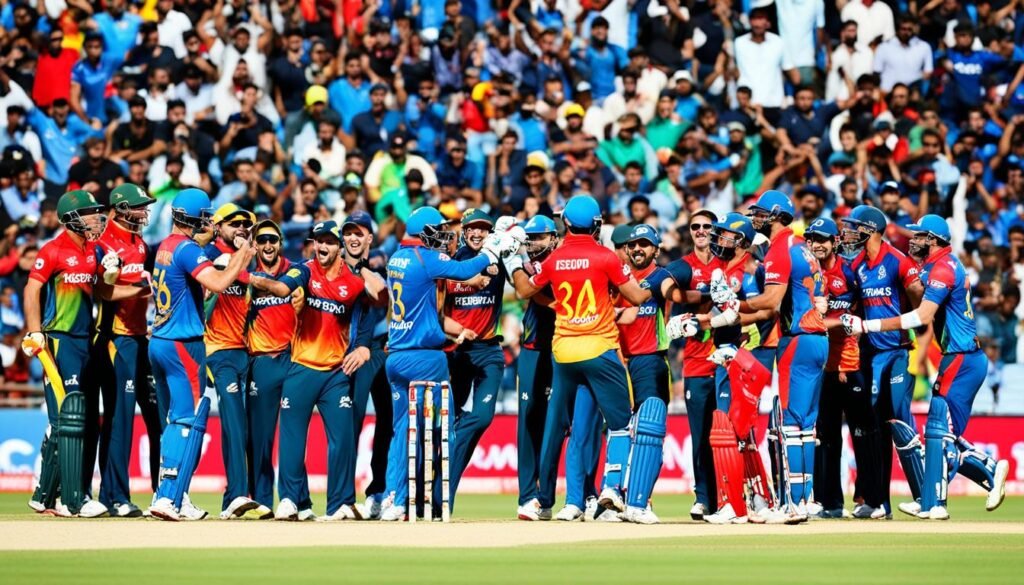Cricket’s cultural impact is undeniable, as the sport has left an indelible mark on societies around the world. With its deep historical significance and globalization, cricket has shaped the identities of nations and fostered a sense of unity among diverse cultures.
The origins of cricket can be traced back to rural England in the 16th century, but its influence quickly spread through the British Empire. Countries like Australia, India, South Africa, and the West Indies embraced the sport, incorporating it into their national fabric.
Cricket’s globalization has led to the establishment of international tournaments and leagues, such as the ICC Cricket World Cup and the Indian Premier League. These events attract players and fans from diverse backgrounds, further enriching the sport’s cultural significance.
As we explore the cultural impact of cricket worldwide, we will delve into its historical origins, expansion beyond borders, and the evolution of different formats. Join us on this fascinating journey through the world of cricket.
Key Takeaways:
- Cricket’s cultural impact is global, shaping the identities and fostering unity among nations.
- The sport originated in rural England and spread through the British Empire.
- International tournaments and leagues attract players and fans from diverse backgrounds.
- Cricket’s historical significance and globalization contribute to its cultural significance.
- Join us as we explore the fascinating journey of cricket’s cultural impact worldwide.
Historical Origins of Cricket
Cricket, a sport with origins in rural England, has evolved from a leisurely pastime to a competitive game that captivates millions around the world. One pivotal institution in the development of cricket was the Marylebone Cricket Club (MCC), founded in 1787. The MCC played a crucial role in shaping the future of the sport by establishing the laws of cricket, which set the foundation for its evolution.
Cricket’s journey began in the English countryside, where it was originally played by shepherds and farmers. Primarily a recreational activity, cricket gained popularity and started to attract players from different social backgrounds. As the sport grew in popularity, it managed to transcend social barriers, uniting people in a shared passion for the game.
Also Read: How Does Network Process Technology Work?
“Cricket is a game that has no barriers; everyone can enjoy it and participate.”
The MCC’s role in cricket’s evolution cannot be overstated. By codifying the laws of the game, the MCC standardized the rules and provided consistency across matches. These laws formed the basis for the sport’s growth and expansion, ensuring a level playing field for all teams and players.
Cricket’s spread beyond England’s borders can be attributed to the British Empire’s colonization efforts. As England established its influence in various parts of the world, cricket followed, becoming an integral part of the sporting cultures of countries like Australia, India, South Africa, and the West Indies.
| Country | Year Introduced | Notable Achievements |
|---|---|---|
| Australia | 18th century | Multiple Cricket World Cup victories |
| India | 18th century | Cricket’s popularity rivaling that of a religion |
| South Africa | 19th century | Hosted the first-ever Test match |
| West Indies | 19th century | International dominance in the 1970s and 1980s |
Today, cricket continues to evolve and thrive, captivating fans worldwide with its rich history and passionate rivalries. The historical origins of cricket and the influence of the MCC have laid the foundation for a global sport that celebrates heritage, skill, and camaraderie.
Also Read: Top Minecraft Server Hosting Choices For 2024
Expansion Beyond Borders

Cricket’s spread beyond England’s borders was facilitated by the expansion of the British Empire. As the empire grew, so did the reach of cricket, with the sport taking hold in countries around the world. Today, cricket has become deeply embedded in the national sporting fabric of countries like Australia, India, the West Indies, and South Africa, each with its own unique cricket culture and passionate fanbase.
In Australia, cricket holds a special place in the nation’s sporting landscape. The sport has a rich history in the country, with the first recorded cricket match taking place in Sydney in 1803. Since then, Australia has produced some of the world’s greatest cricketers and has been a dominant force in international cricket, winning numerous Ashes series against England and multiple ICC Cricket World Cups.
In India, cricket is more than just a game; it is a national passion. With a population of over 1.3 billion people, India has a fanatical cricket following, and the Indian cricket team is revered as national heroes. Cricket in India has become a symbol of unity and cultural identity, transcending boundaries and language barriers.
Also Read: Smart Money Habits: Financial Goals For Students
The West Indies, made up of multiple Caribbean nations, has a rich cricketing heritage. The region has produced legendary players like Sir Garfield Sobers, Brian Lara, and Viv Richards, who have solidified the West Indies’ reputation as a powerhouse in the cricketing world. The sport holds immense cultural significance in the West Indies, with matches against England and Australia in particular drawing fervent support and capturing the region’s spirit of camaraderie.
Cricket has also played a significant role in South Africa’s sporting history. Despite being isolated from international cricket for many years due to apartheid, South Africa has produced exceptional players and has made a strong impact on the global cricket stage since its readmission in 1991. The Proteas, as the national team is known, are known for their competitive spirit and have consistently been a force to be reckoned with in international cricket.
In summary, cricket’s expansion beyond England’s borders has led to the emergence of vibrant cricketing cultures in Australia, India, the West Indies, and South Africa. With passionate fans, storied histories, and a deep sense of national identity, these countries have become pillars of the global cricketing community.
The Test Match Era
The late 19th century witnessed the emergence of Test cricket, a format that would establish its dominance in the sport for over a century. During this era, one of the most fiercely competitive and enduring rivalries in cricket took shape – the Ashes series between England and Australia. Test cricket captivated fans with its longer matches and strategic gameplay, attracting a dedicated following who appreciated the intricacies of the game.
This format of cricket, known as Test cricket, is considered the ultimate test of a player’s skills and endurance. The matches span several days, allowing teams to showcase their talent, resilience, and tactical prowess. Throughout the decades, Test cricket has produced legendary players and memorable moments that have become etched in cricketing history.
Also Read: Unveiling The Secret To Reversing Skin Aging – Anti-Aging Skin Clinic’s Groundbreaking Techniques
“Test cricket is the pinnacle of the sport. It tests a player’s character, technique, and ability to perform under pressure. The Ashes series, in particular, showcases the fierce rivalry and competitive spirit between England and Australia, captivating fans all over the world.”
The Ashes series is a biennial event that has created an indelible mark in the cricketing world. It originated in 1882 when Australia defeated England for the first time on English soil. The famous obituary published in the Sporting Times stating that English cricket had died, and “the body will be cremated and the ashes taken to Australia” sparked the birth of the Ashes name. The series has since become a symbol of the enduring rivalry between the two nations and has consistently delivered intense battles on the cricket field.
Over the years, the Ashes series has produced iconic moments, legendary players, and thrilling contests that have captivated cricket enthusiasts worldwide. From the fierce pace of Dennis Lillee and Jeff Thomson to the elegant batting of Don Bradman and Sir Viv Richards, the Ashes series has witnessed some of the most memorable performances in cricket history.
The Ashes Series – Historical Overview
| Year | Venue | Winner |
|---|---|---|
| 1882 | The Oval, London | Australia |
| 1884/85 | Melbourne Cricket Ground | England |
| 1886 | The Oval, London | Australia |
| 1887/88 | Adelaide Oval | Australia |
| 1888 | Kennington Oval, London | Australia |
| 1890/91 | Sydney Cricket Ground | Australia |
| 1891 | Kennington Oval, London | England |
| 1893 | Old Trafford, Manchester | England |
| 1894/95 | Sydney Cricket Ground | England |
| … | … | … |
| 2021/22 | TBD | TBD |
The Ashes series continues to be a pinnacle of Test cricket, embodying the enduring rivalries and the undying spirit of the game.
Also Read: Defy Aging Naturally – Innovative Solutions For Youthful Skin
Limited-Overs Cricket

In the 1960s, cricket underwent a transformation with the emergence of limited-overs cricket, which introduced a faster-paced and more spectator-friendly version of the game. One-Day Internationals (ODIs) became a shorter format that provided an exciting alternative to the traditional Test cricket. This format allowed matches to be played within a single day, capturing the attention of both players and fans.
One of the most significant events in the evolution of limited-overs cricket was the inaugural Cricket World Cup in 1975. This tournament brought together teams from around the world to compete for the sport’s most prestigious trophy. The Cricket World Cup further popularized the shorter format and showcased the excitement and competitiveness that it offered.
Limited-overs cricket has its own unique charm, with matches packed full of action and drama. The shorter format encourages aggressive batting, bowling, and fielding strategies, making it an exhilarating spectacle for both players and spectators.
The Cricket World Cup
The Cricket World Cup, held every four years, is a showcase of talent, skill, and determination. It brings together the top cricketing nations to compete on a global stage, vying for the coveted title of world champions. The tournament has witnessed historic performances, unforgettable moments, and intense rivalries, capturing the hearts of cricket fans worldwide.
Here are some key highlights from the history of the Cricket World Cup:
- The West Indies dominated the early years, winning the first two editions in 1975 and 1979.
- Australia emerged as a cricketing powerhouse, securing five World Cup victories between 1987 and 2015.
- The Indian cricket team triumphed in 1983 and again in 2011, igniting a fervor for the game in the cricket-crazy nation.
- Sri Lanka’s legendary spinner, Muttiah Muralitharan, holds the record for the most wickets in World Cup history.
- Sachin Tendulkar, a cricketing icon from India, holds numerous World Cup records, including the most runs scored.
The Cricket World Cup has become a platform for players to etch their names into cricketing history and create enduring memories. It showcases the pinnacle of limited-overs cricket and captivates audiences around the world.
The T20 Revolution

In the 21st century, Twenty20 (T20) cricket emerged as an even shorter and more dynamic format that appealed to modern audiences with limited attention spans. This format revolutionized the game of cricket by introducing fast-paced matches that provided constant excitement and entertainment.
The Indian Premier League (IPL), launched in 2008, played a pivotal role in popularizing T20 cricket and taking the sport to new heights. Combining cricket with entertainment, the IPL became a global phenomenon, attracting the best players from around the world and captivating millions of fans.
The IPL’s success paved the way for the establishment of T20 leagues in other countries, such as the Big Bash League in Australia and the Caribbean Premier League in the West Indies. These leagues followed the IPL’s model of combining cricket with glitz and glamour, further solidifying the global popularity of T20 cricket.
The Indian Premier League (IPL)
The Indian Premier League (IPL) is a professional T20 cricket league in India. It features franchise teams representing different cities, and it has quickly become one of the most-watched and highly anticipated sporting events in the world.
T20 Leagues Worldwide
Following the success of the IPL, T20 leagues have sprung up in several countries, providing opportunities for players to showcase their skills and earn lucrative contracts. Some of the prominent T20 leagues include:
- Big Bash League (BBL) – Australia
- Caribbean Premier League (CPL) – West Indies
- Vitality Blast – England
- Mzansi Super League (MSL) – South Africa
- Tamil Nadu Premier League (TNPL) – India
These leagues have not only attracted international players but have also unearthed local talents, contributing to the growth and development of cricket in their respective regions.
The Global Popularity of T20 Cricket
The emergence of T20 cricket and the success of leagues like the IPL have significantly contributed to the global popularity of the sport. This fast-paced and exciting format has captured the attention and imagination of fans worldwide, transcending traditional cricket-playing nations.
The global popularity of T20 cricket is evident in the massive viewership, high attendance at matches, and the commercial success of leagues. The format’s shorter duration makes it more accessible to a wider audience, leading to its wider acceptance and adoption across cricket-playing countries.
T20 cricket has also provided a platform for cricket to reach newer markets and engage with a younger demographic. The combination of sporting prowess, entertainment, and glamour has created a unique sporting spectacle, cementing T20 cricket’s position as one of the most followed and celebrated formats in the world.
Women’s Cricket

The rise of women’s cricket has been a remarkable development in recent years. The International Cricket Council (ICC) has played a crucial role in promoting and organizing women’s cricket tournaments, including the Women’s Cricket World Cup and the Women’s T20 World Cup. The increased visibility and investment in women’s cricket have paved the way for more opportunities and inspired a new generation of female cricketers.
Women’s cricket has come a long way in breaking barriers and challenging stereotypes. The ICC’s efforts to support and develop the women’s game have been instrumental in its growth and recognition on the global stage. The Women’s Cricket World Cup, held every four years, showcases the best talent from around the world and provides a platform for women to excel in the sport they love.
The Women’s T20 World Cup, introduced in 2009, has further accelerated the growth of women’s cricket. This shorter format of the game offers thrilling and fast-paced matches that captivate audiences worldwide. The tournament has witnessed some unforgettable moments and outstanding performances, contributing to the rise of women’s cricket as a force to be reckoned with.
“The development of women’s cricket is essential in creating a more inclusive and diverse sporting landscape. Through initiatives like the Women’s Cricket World Cup and the Women’s T20 World Cup, we are empowering female cricketers and inspiring future generations.” – ICC spokesperson
The progress of women’s cricket is not limited to international tournaments. Domestic leagues around the world, such as the Women’s Big Bash League in Australia and the Kia Super League in England, have provided a platform for talented players to showcase their skills and compete at a high level. These leagues have also played a crucial role in attracting new fans and creating a sustainable ecosystem for women’s cricket.
As women’s cricket continues to grow in popularity and visibility, it brings with it new role models and opportunities for young girls aspiring to play the sport. The success of players like Ellyse Perry, Meg Lanning, and Harmanpreet Kaur has not only elevated the profile of women’s cricket but also inspired a new generation of female cricketers to dream big and believe in their abilities.
The Impact of Women’s Cricket on Gender Equality
The rise of women’s cricket goes beyond the sport itself. It symbolizes progress in the journey towards gender equality and challenges traditional gender norms. Women’s cricket has shattered stereotypes and created a space where talent and skill, rather than gender, are the primary factors for success.
“Women’s cricket is breaking barriers and empowering women to push boundaries both on and off the field. It is inspiring a future generation of strong, resilient, and ambitious women who will make a positive impact in all aspects of life.” – Cricket enthusiast
Women’s cricket has not only provided a platform for female athletes to showcase their talent but has also been a catalyst for societal change. By promoting inclusivity, equality, and respect, women’s cricket is challenging societal norms and paving the way for a more equitable future.
| Benefits of Women’s Cricket |
|---|
| Empowers women and provides opportunities in the sporting arena |
| Encourages gender equality and challenges traditional gender roles |
| Inspires young girls to pursue their passion for cricket |
| Creates role models for future generations |
| Provides a positive impact on society by promoting inclusivity |
With increased investment, support, and recognition, women’s cricket is poised to reach new heights in the coming years. The International Cricket Council’s commitment to the growth and development of women’s cricket will ensure that the momentum continues and that women have an equal and prominent place in the future of the sport.
Cricket’s Cultural Significance in India

Cricket in India is more than just a game. It is a national passion that unites the diverse population of the country, transcending boundaries, languages, and regions. The sport holds a special place in the hearts of Indians, and its cultural significance cannot be overstated.
The Indian cricket team’s successes on the international stage are celebrated as moments of immense national joy. The victories become emblematic of the collective hopes and dreams of the nation, igniting a sense of pride and patriotism that resonates with every Indian. Cricket has the power to bring people together, fostering a sense of unity and camaraderie among fans across the country. It serves as a cultural identifier, defining the national identity of India.
The popularity of cricket in India has led to the emergence of legends who have become national icons. Players like Sachin Tendulkar, Kapil Dev, and Virat Kohli have not only achieved great success on the cricket field but have also captured the imagination of the entire nation. These cricketers are revered as heroes and role models, inspiring generations of aspiring players.
“Cricket is more than a sport in India; it is a way of life. It brings people together, transcending social and cultural barriers. The passion for cricket runs deep in the veins of every Indian, and it is an integral part of our cultural fabric.” – Anil Kumble
The Indian Premier League (IPL), a T20 cricket league, has further amplified the cricketing frenzy in the country. The IPL showcases the best of Indian and international talent, creating a platform for young cricketers to shine and for fans to witness exhilarating matches. The league has become a cultural extravaganza, where cricket is intertwined with entertainment, music, and celebrity culture.
Cricket’s cultural significance in India goes beyond the sport itself. It serves as a unifying force that brings people of diverse backgrounds together, fostering a sense of community and national pride. It is a reflection of India’s rich cultural heritage and the indomitable spirit of its people.
| Cricket’s Cultural Significance in India | Key Points |
|---|---|
| National Passion | Cricket is more than just a sport in India; it is a national passion that holds immense significance in the lives of the people. |
| Cultural Identity | Cricket serves as a symbol of cultural identity, representing the spirit and values of the Indian people. |
| Unifying Force | Cricket brings people together, transcending social, linguistic, and regional differences, and fostering a sense of unity and camaraderie. |
| Heroes and Icons | Legendary cricketers have become national icons, inspiring generations of aspiring players and capturing the hearts of the entire nation. |
| IPL and Entertainment | The Indian Premier League (IPL) combines cricket with entertainment, creating a cultural extravaganza that showcases the best of Indian and international talent. |
Conclusion
Cricket’s impact on culture and its global popularity are undeniable. This sport that originated in England has now spread to various corners of the world, shaping the identities of nations and fostering a sense of unity among diverse cultures. From its early days as a leisurely pastime to the modern era of fast-paced T20 cricket, the evolution of the game has contributed to its widespread appeal.
The globalization of cricket has led to the formation of international tournaments and leagues that attract players and fans from all walks of life. The ICC Cricket World Cup and the Indian Premier League have become major events, showcasing the skill and passion of cricketers on a global stage. Additionally, the rise of women’s cricket has paved the way for greater inclusivity and opportunities within the sport.
Cricket’s impact goes beyond the boundaries of the playing field. It has become a symbol of passion, competition, and camaraderie, leaving an indelible mark on societies worldwide. Whether it’s the cricket-crazy fans in India, the enduring rivalries in Test matches, or the excitement of T20 cricket, the sport continues to captivate audiences and create a sense of belonging. With its rich history, cultural significance, and global reach, cricket will undoubtedly remain an integral part of our world for generations to come.
Also Refer : Cricket’s Global Appeal: Why The Sport Transcends Borders And Boundaries
FAQs
Q: What is the global reach of cricket?
A: Cricket has a global reach, with fans from different backgrounds and countries across the globe. It is one of the most popular sports worldwide.
Q: How has cricket played a profound impact on cultural exchange?
A: Cricket has played a profound impact on cultural exchange, acting as a cultural ambassador and promoting the sport across the globe, fostering love for the sport beyond the boundary ropes.
Q: What are some international competitions in cricket?
A: Events like the ICC Cricket World Cup and cricket tours are examples of international competitions in cricket where teams from different countries participate.
Q: Why is cricket considered a shared passion between England and Australia?
A: Cricket is considered a shared passion between England and Australia due to the strong cricketing history of both countries, with the sport being played between them in 1877, and making the sport more accessible in their respective nations.
Q: How does cricket transcend different cultures?
A: Cricket transcends different cultures by bringing people from different backgrounds together to celebrate the sport, fostering a love for the game that goes beyond national boundaries.
Q: What is the significance of India and Pakistan in the world of cricket?
A: India and Pakistan hold a significant place in the world of cricket, with a strong cricketing tradition and unwavering love for the game, making significant contributions to the sport internationally.
Q: How does cricket act as a cultural ambassador?
A: Cricket acts as a cultural ambassador by promoting the sport and fostering a love for cricket across the globe, leading to cultural exchange and celebration of the sport in different countries.
Q: What are some notable cricket events that have a global impact?
A: Events like the ICC Cricket World Cup and cricket tours are notable cricket events that have a global impact, attracting fans from different countries and promoting the sport internationally.
Q: Why do fans from different countries have a strong connection to cricket?
A: Fans from different countries have a strong connection to cricket due to the influence of cricket stars and the sport’s popularity, fostering a love for the game that goes beyond national boundaries.
Q: How has cricket influenced the cultural landscape worldwide?
A: Cricket has influenced the cultural landscape worldwide by being one of the most popular sports, with a rich history and significant impact on cultural exchange, making it a global phenomenon.




